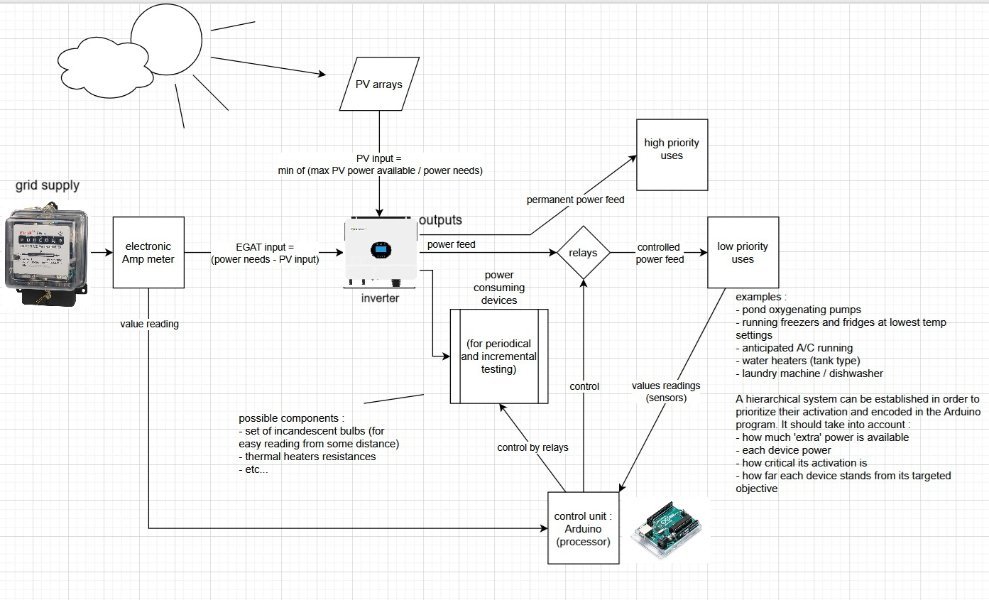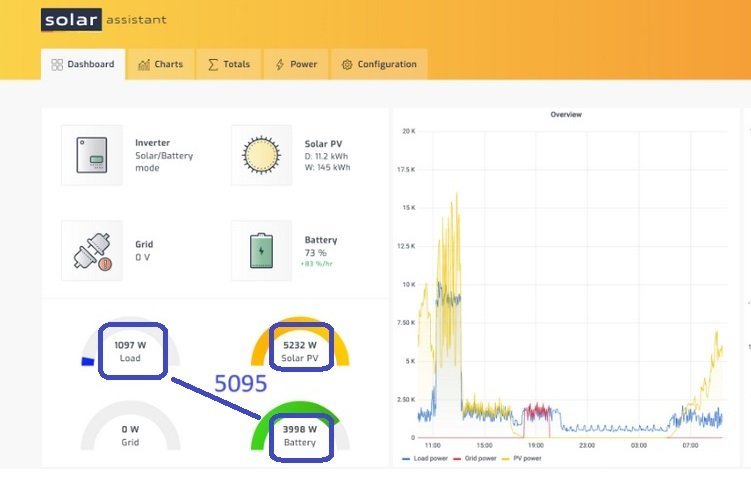-
Posts
799 -
Joined
-
Last visited
Recent Profile Visitors
8,172 profile views
Mitker's Achievements
-
Sorry for this long silence. I've read all your posts, have been looking for info on the web and did a little of processing of all that. I'll post here what's my plan at this stage and, if the topic doesn't get closed due to low activity, I'll post later how it takes shape practically since I think it may be useful for other readers in the future facing the same question. I made a simple flow chart (attached) to illustrate how I see it after checking the leads you gave me - thanks a lot to all of you for these ! It starts obviously by reading the current supplied by the grid to the inverter, since any positive reading means all the PV supply is used up already : case closed I'll install a reading device (like these @lom and @Bandersnatch mention) to retrieve the info. Even if at first I rejected the idea, I'll go the way of empirically testing the amount of unused solar power the panels can supply at a given time by progressively turning on a set of power-using devices (cfr @JBChiangRai and @lom posts) The data processing and control of the devices will be managed by an Arduino board. ... and in a later stage : In order to optimize the scheme, there are thus a few more options: - establishing a reference curve (gathered from real conditions readings) of the maximum potential output of the arrays in full sunny conditions and exploiting it to improve the model. cfr @JBChiangRai approach - since using only the real time unused power can lead to constant switching on and off of the devices, estimating the general weather conditions of the moment would be useful to add to the data to be taken into account. It could be an app (like the Solcast @Crossy mentions) or it could be a hardware setup reading the luminosity in a cone - like 45° wide - around the sun position. That way, the board can smoothen the cycles based on objective conditions. The first option means being able to extract the infos from the app to be exploitable by the processor. The second means getting my tools ready. - I've also been told that the PV voltage reading of the PV supply could help estimate the unused power, the rationale being that it was a direct result of the inverter restricting the PV input to its current needs, and that the right equation would give the answer (arrays specs being the main part of it). The explanations I got far exceed my skills in the field so that I won't go that way... Thanks again 😉
-

Video Ex-Air Hostess Charlotte Lee Arrested for £1.5m Cannabis in Sri Lanka
Mitker replied to snoop1130's topic in Thailand News
Another scenario is that BKK detected the stuff and liaised with Colombo to inform them, so they could catch her at arrival (saving themselves all the hassle involved)- 112 replies
-
- 21
-

-

-

-

-

Community Naked Foreign Man Escapes Hospital, Runs Amok in Pattaya Streets
Mitker replied to Georgealbert's topic in Pattaya News
No idea what's on this picture.. -

Economy Thailand Sets Sights on Growing Sustainable Protein Market
Mitker replied to snoop1130's topic in Thailand News
We had a home-made pizza with cricket topping the other day Excellent and no side effects after that The walnut smell emitted when cooking is amazing Just think that they're part of the same family as shrimps (that we have no trouble eating) -
Thanks for these They seem to confirm what @JBChiangRai was explaining about the extra potential production being unknown by the inverter (my hope was that, by having to 'discard' this excess some way, it would be able to figure it out..) This being said, I'll consider the Solar Assistant app for the other features
-
That's an interesting approach I didn't think about. Thanks By modelling a theoretical curve of the power generated by the system in sunny conditions on one side (as you did), and by comparing it with the data provided by a small panel as an indicator of the real conditions on the other side, maybe that combining both information would make it possible to estimate quite precisely the total power available at a given moment The next step would be to deduct the loads at that moment to have an idea of what's left available
-
Thanks for these infos Interesting to see that from the screenshot you sent, it looks like you get this very data I'm looking for, under the 'solar PV' wattage figure (5232 W). My only uncertainty it that this value is very close (by a couple of %) to the sum of the loads and the battery charge. Would this be due that by chance that day your use was that close from what the system was generating, or that what appears under 'solar PV' is just the sum of the uses plus some losses and roundings ? In the later case, it wouldn't inform about the 'untapped' portion of solar power Does it happen that the dashboard shows value of 'solar pv' wattage significantly higher than your loads + battery charge ? And yes, I had seen your video about the wifi remotely controlled breaker. Very convenient and I'm currently thinking about something like this for my own system Thanks again
-
Hi, I started running a Growatt SPF6000ES inverter, with which I'm globally satisfied, on an On-Grid (but no export) configuration. No batteries at this stage. In order to optimize the system, meanwhile the primary devices are already running and if there's any power produced by the panels unused, I'd like to automatically launch secondary equipments (ex: oxygenating pumps for the ponds, tank water heater, etc.). This implies I would need to collect this information (amount of extra power available) first, in real time and continuously. My question is : Is this a data that can be retrieved somehow from the inverter ? (I have no idea if the inverter is even in condition to estimate this value) I didn't find any mention of this on the UM or searching on the net. Thanks for any info or experience on the topic, ps: definitely not a geek in electronics, but I should be able to write down and inject some basic code on a board that would process the data and run a few relays accordingly 😉 ps2: I don't want to go the empirical way (progressively increasing loads until detecting the inverter must draw from the grid) - unpractical
-
I think it is due to the proximity of the 'capturing device' (and the light conditions) and the distortion it creates The shorter the distance, the worse the distortion of the image Typically, a selfie will be an arm length away A mirror will usually be quite further and the 'image' will do a return trip from your face back to your eyes, so double this distance : your appearance will be much closer to the reality (plus, typically, mirrors are placed in an environment with favorable lighting) my 50 cents
-
From my experience, filtration is the key. I've never been able to totally get rid of chlorine, but I've succeeded reducing it to a ridiculous amount (for a small pool of 16 m3, a single tablet would suffice for 2-4 weeks use in plain Mediterranean summer). It was mostly needed at starting the season. The filter would run most of the day with adequate backwash every couple of days. Your solar system will erase the cost. You'd never smell any chlorine Removing any debris (min-skimmers ?) and preventing users to use the pool without prior shower are a must Good luck with your project (I actually plan something very similar and will follow this discussion)
-
If this could be of any use for someone looking into the topic : - We got in touch with a sales representative who asked 'the engineer'. After a while, we received an answer to our question : "yes" (it can manage Sodium-Ion batteries). I personally would have loved a somewhat more documented answer going further into the settings flexibility, but I guess we should be happy with that - The SPF-5000ES has been discontinued and is replaced by the SPF6000 ES Plus











